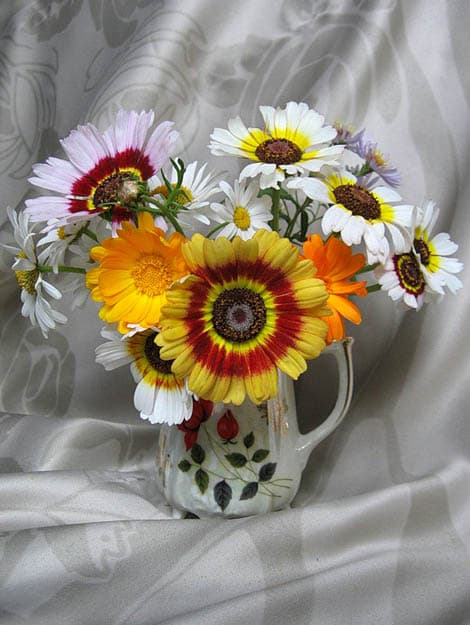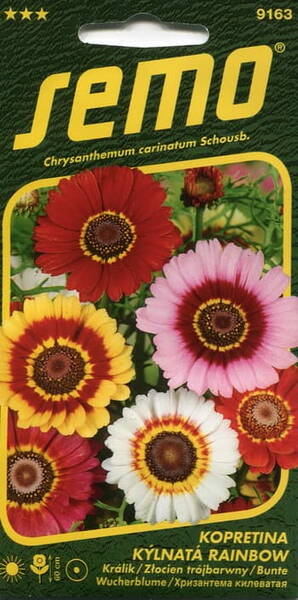Elegant flowers all summer long!
A densely branched, upright plant up to 70 cm tall. Characterized by rapid growth and early, long-lasting flowering (from June to October). It is used for planting in flowerbeds, mixed groups, borders, and for cut flowers.
Agricultural technology.
The plant loves light, is cold-hardy, and fairly drought-resistant. It prefers light, moderately fertile soils.
Sow seeds in April in seedling trays, lightly covering with soil. At soil temperatures of 18-25°C, seedlings emerge in 10-18 days. Plant in a permanent location in mid-May; direct sowing into the ground is also possible in early May. Space plants 35-40 cm apart.

Tricolor daisy, tricolor chrysanthemum. Bot. syn.: Chrysanthemum tricolor Andr., Ismelia carinata (Schousb.), Glebionis carinatum.
* Pests and diseases of chrysanthemums:
Powdery mildew.
It causes a disease of chrysanthemums in open ground and greenhouses. The disease is characterized by the formation of a white coating on the surface of affected leaves and shoots, sometimes completely covering them. As a result, the leaves and shoots become stunted and die.
Downy mildew.
Leaves, stems, and flowers are affected. The disease is characterized by the appearance of yellowish spots on the leaf surface, followed by the development of a whitish coating on the underside, consisting of the fungal conidial sporulation organs. As the disease progresses, the coating gradually spreads to the stems and flowers. Affected leaves dry out, and the inflorescences die. Excessive humidity, poor ventilation, and elevated air temperatures contribute to the development of the disease.
Gray rot.
Gray mold affects leaves, stems, and flowers and is particularly damaging in greenhouses and conservatories. This disease causes a gray coating consisting of mycelium and sporulation organs to form on the affected plant parts. Affected plant parts wilt, rot, and die. Weakened plants are particularly susceptible to this disease.
Rust.
In greenhouses, chrysanthemums are severely affected by rust, which causes the plants to gradually dry out and die. This parasite only occurs on chrysanthemums in the uredospore stage, which allows the fungus to develop in greenhouses year after year, causing significant damage to the horticultural industry.
Leaf spot.
A dangerous disease that causes severe leaf damage in greenhouses. When this disease appears, the leaf surface becomes covered with round, brownish-red spots surrounded by a wide brown border. Initially, individual small spots appear on the leaves, which gradually increase in number and size. Later, the spots merge and cover most or all of the leaf blade. Affected leaves dry up and fall off. Fruiting organs of the fungus appear on the surface of the spots as small black dots. The infection persists on affected leaves year after year.












